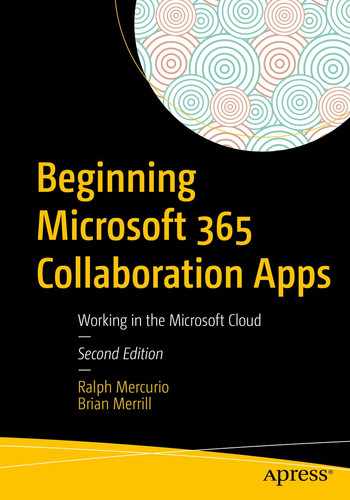Welcome to Beginning Microsoft 365 Collaboration Apps. My intention with this book is to introduce the concepts behind Microsoft 365, how it works, and what it can offer you regarding functionality, collaboration, and ease of use. There are many applications within Microsoft 365, and I will focus on the specific applications that foster collaboration, dedicating a chapter to each.
In this book, I will discuss SharePoint, OneDrive, Teams, Office, and a few other applications that make up Microsoft 365. I will also introduce two relatively new applications from Microsoft: Stream and Power Automate. Microsoft Stream is a video sharing and collaboration application; Power Automate connects workflow actions across most of Microsoft 365 and external applications.
In this chapter, I will approach Microsoft 365 from a very high level, including a perspective on collaboration and how it has evolved throughout the years. It is important to understand and acknowledge the past and present as Microsoft 365 lays the foundation for workplace collaboration in the future. I will also discuss how to set up a Microsoft 365 account so that you can experiment and follow along. I am a firm believer in doing as opposed to reading because it reinforces the content and allows you to become familiar with and confident in the interface and nuances of Microsoft 365.
As we navigate through the various chapters of this book, please be aware that Microsoft has changed the name of the product from Office 365 to Microsoft 365. This change aligns the platform with its use and eases some of the confusion of the old name. Due to this change, some parts of the platform have not been fully updated by Microsoft with regard to the name change, but for our purposes we will refer to the platform as Microsoft 365.
Collaboration in the Workplace
Collaboration has changed over the years from a rigid structure to a more flexible model that embraces technology and allows information workers to have more freedom and control over getting their work completed. Microsoft classifies information workers as employees who consume and create content. This includes nearly every department of an organization; some examples of content are budgets, employee records, project documents, technical guides, and forms. With that, not all companies embrace the model, and they prefer (sometimes strongly) that employees report to a company office location to perform their duties.
As we all are aware, the global pandemic of 2020 has brought on a new way of working. The Covid-19 pandemic quickly changed the way corporate leaders thought of remote work, the safety and well-being of their employees, and the acceptance of technology, which has fundamentally shifted the way we work today.
Overnight, information workers found themselves in a new way of working, and IT departments scrambled to find ways to connect people back to work. For many companies, Microsoft 365 was the chosen platform to enable information workers to be productive and have access to the information they needed.
As technology has evolved outside the workplace and made our lives arguably easier, technology has also evolved inside the workplace as we are aware of it. In today’s workplace, you can have a video conference with someone halfway around the world and see and hear them in high definition. You can also search and retrieve email messages from years ago or get your mail on your mobile device with all the bells and whistles you expect.
Part of the allure of Microsoft 365 is that the content you are interested in is searchable and relevant. Think back 20 years ago and how you found information before the introduction of search engines, notably Google. To think I once used Microsoft Encarta or asked for a ride to the library to access their collection of Encyclopedia Britannica volumes, it boggles my mind to this day. Now Microsoft 365 is capable of searching across email, SharePoint, OneDrive, and the other applications to ensure you find the relevant item; it is even capable of searching within the document to improve its relevancy.
In some cases, a VPN connection is still required to access large systems such as an ERP system, a billing system, and custom-built applications that aren’t available outside of the company through a proxy or some other means. I won’t touch base on Azure, which is another Microsoft offering for companies looking to use IaaS (Infrastructure as a Service).
Today’s collaboration tools allow for the sharing of information, which ultimately improves processes, boosts the bottom line, and delivers well-executed projects. Individuals working in a silo can’t bounce ideas off each other or seek out other experienced individuals and so must bear the cost of a poorly executed project.
An excellent example of how collaboration works is to think of a group of university professors aligning their resources and experiences to deliver a well-received article or a world-changing vaccine. If they worked in their isolated environments, their outcomes and innovations might be much less impactful.
In the business world, teams collaborate around the launch of a new product, which involves teams from marketing, technology, sales, and leadership. This type of activity may include geographically dispersed teams or team members in other offices around the world. Technology must bring them all together so the objectives can be met and the product gets to market.
Part of the design and success of Microsoft 365 is that it allows companies to have a digital workplace. It allows companies and employees to have the tools to not only collaborate but get work done on their time on a cloud-based platform supported by Microsoft. It provides applications around the way people need to work, whether that is document-based, email, chat, or video collaboration; Microsoft 365 moves the common applications we use daily to the cloud and allows us to use the tools and applications we need to get our job done.
Let’s dig into Microsoft 365 and discuss its elements and why it makes business sense to move to it.
What Is Microsoft 365?
Microsoft 365 is Microsoft’s SaaS offering for email, collaboration applications, and Office ProPlus. SaaS stands for Software as a Service . The easiest way to understand the concept is that you simply sign into a website and access the software instead of installing it locally on your PC or Apple device. Popular examples of SaaS are not only Microsoft 365 but QuickBooks and Salesforce.
With SaaS, there generally is no software to install; the vendor maintains and supplies the software, updates, and hardware needed to run the software. In turn, you simply pay a monthly fee, and you have access to the software or platform.
Microsoft 365 is Microsoft’s biggest software endeavor yet and has been years in the making. For over 25 years, Microsoft has been developing software to be installed on a company’s servers within a company’s data center. This includes not only Microsoft Exchange (email) but also products like Microsoft SharePoint, which was first released in the early 2000s. This approach required companies to buy and maintain expensive server equipment and needed the appropriate technical staff to support the systems.
Microsoft 365 changes the game by removing the need to buy expensive servers or ensure that the IT staff are trained to administer and support the software. By transitioning to Microsoft 365, IT departments and personnel can now focus on providing solutions that can help a business grow instead of managing software and infrastructure.
How Does It Work?
Microsoft maintains data centers around the world in many different regions to be able to offer this service. Each data center contains thousands of servers in perfectly stacked arrays with multiple electrical connections, cooling equipment, on-site support, and all in a highly secure facility with various levels of protection. Because Microsoft provides all the hardware, it also maintains an extensive disaster recovery plan. If one of the data centers were to experience an outage or catastrophic event, Microsoft 365 and its users would see minimum disruption and minimal downtime, if any. This model is also supported by a financially backed service-level agreement (SLA), ensuring that if Microsoft doesn’t maintain its agreed SLA, there is a financial penalty for the company.
But all of this doesn’t matter because of the beauty of all it is that you simply go to Office.com from any major supported web browser and log in with your credentials. Once authenticated, you will be presented with a variety of applications to choose from. From an end user perspective, that is 100% correct, but let’s take a brief look at what must happen first to make it a seamless experience for the end user.
Microsoft 365 comes in a variety of license levels, each with a different per-user cost. This book will focus on Microsoft 365 for Business and Microsoft 365 for Enterprise; some applications will not be available for education, government, and nonprofit license levels. This is relevant because if an application we are discussing is not available to you, it could be because of the plan your company has subscribed to or a licensing issue.
Some applications or features discussed in this book may not be visible to you because you may not have an appropriate license assigned to you to use them. If an application is not visible, your IT department may need to assign a license to you to use it.
Companies have the option to determine when updates and new functionality get released to their respective tenants. This is known as the release preferences. By default, Microsoft sets all tenants to “standard release.” This means that updates and applications are deployed when they are publicly available and not in beta. Companies have the option to set the Microsoft 365 tenant to “targeted release for everyone” and “targeted release for selected users.” “Targeted release for everyone” means that everyone who is using Microsoft 365 in your organization will get Microsoft 365 updates during the first phase of deployment. This will introduce functionality and features before the majority of Microsoft 365 tenants get the updates. “Targeted release for selected users” allows updates and features to be deployed to a specific set of selected users. This is useful to test and review updates before they are deployed to everyone. Keep in mind that some updates only get deployed to the entire organization. The interesting part of this feature is that it allows Microsoft to be agile by monitoring support tickets and fixing issues before the update is deployed to everyone using Microsoft 365.
If you do not have access to Microsoft 365 or if your company will not license the appropriate applications to you, Microsoft will allow a 30-day trial to be created, and you will have access to the applications discussed in this book. After 30 days, your account will be deactivated by Microsoft. You also will be able to purchase a single license monthly if you want to experiment for a longer period.
Why Should You Choose Microsoft 365?
Microsoft 365 combines the best of the Microsoft products with an amazing, proven infrastructure platform all for a price that makes it attractive to businesses. And because it is SaaS, the service is continually updated and made better each day. These new additions can be taken advantage of on day one without the typical installation and planning that traditional software requires.
If you already have access to Microsoft 365 and the related applications, feel free to skip to the next section. This next section is intended for users who do not have access to a Microsoft 365 tenant or wish to create one simply as an exercise in conjunction with this book.
Creating the Microsoft 365 Trial Tenant
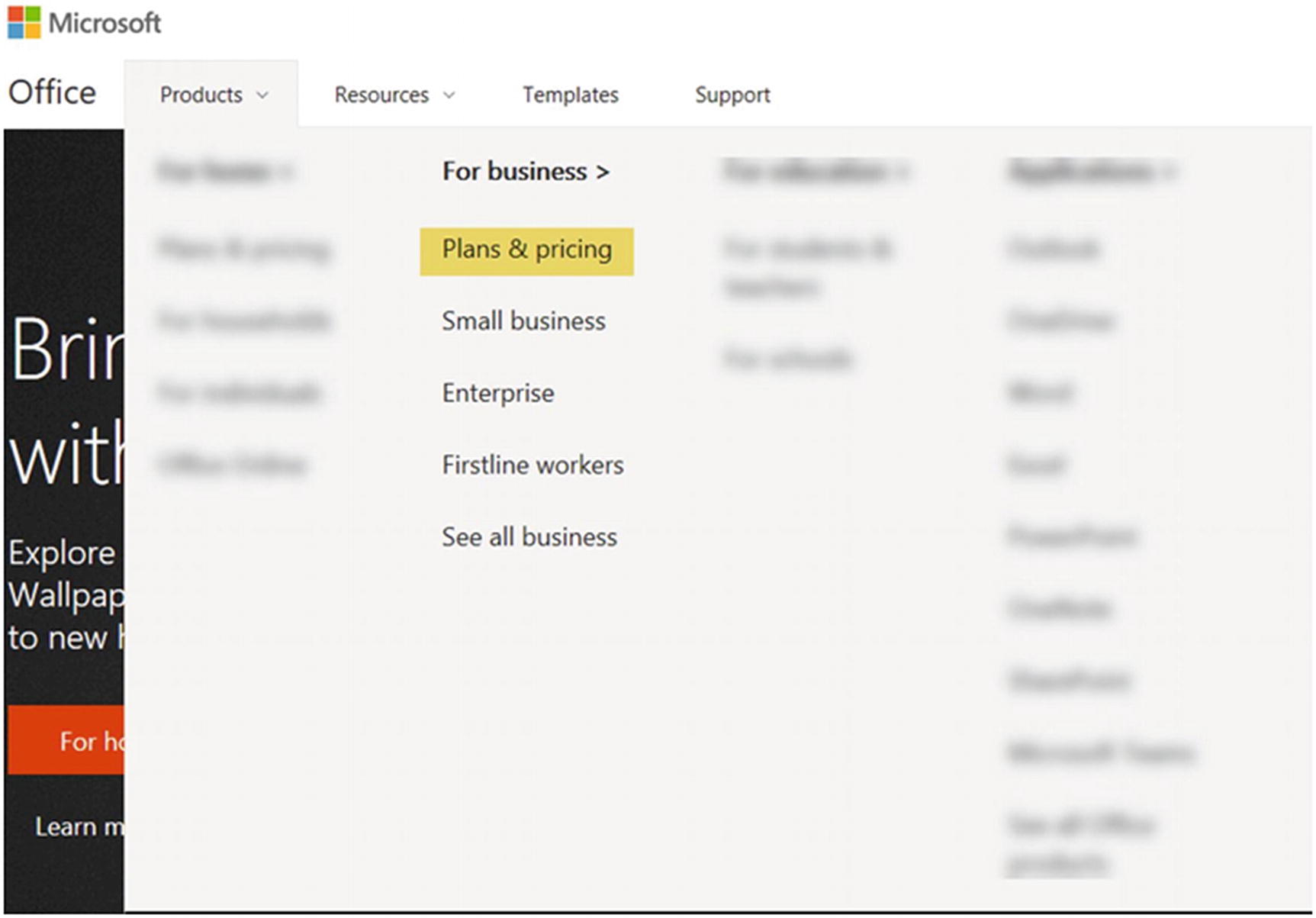
Creating the trial account for Microsoft 365
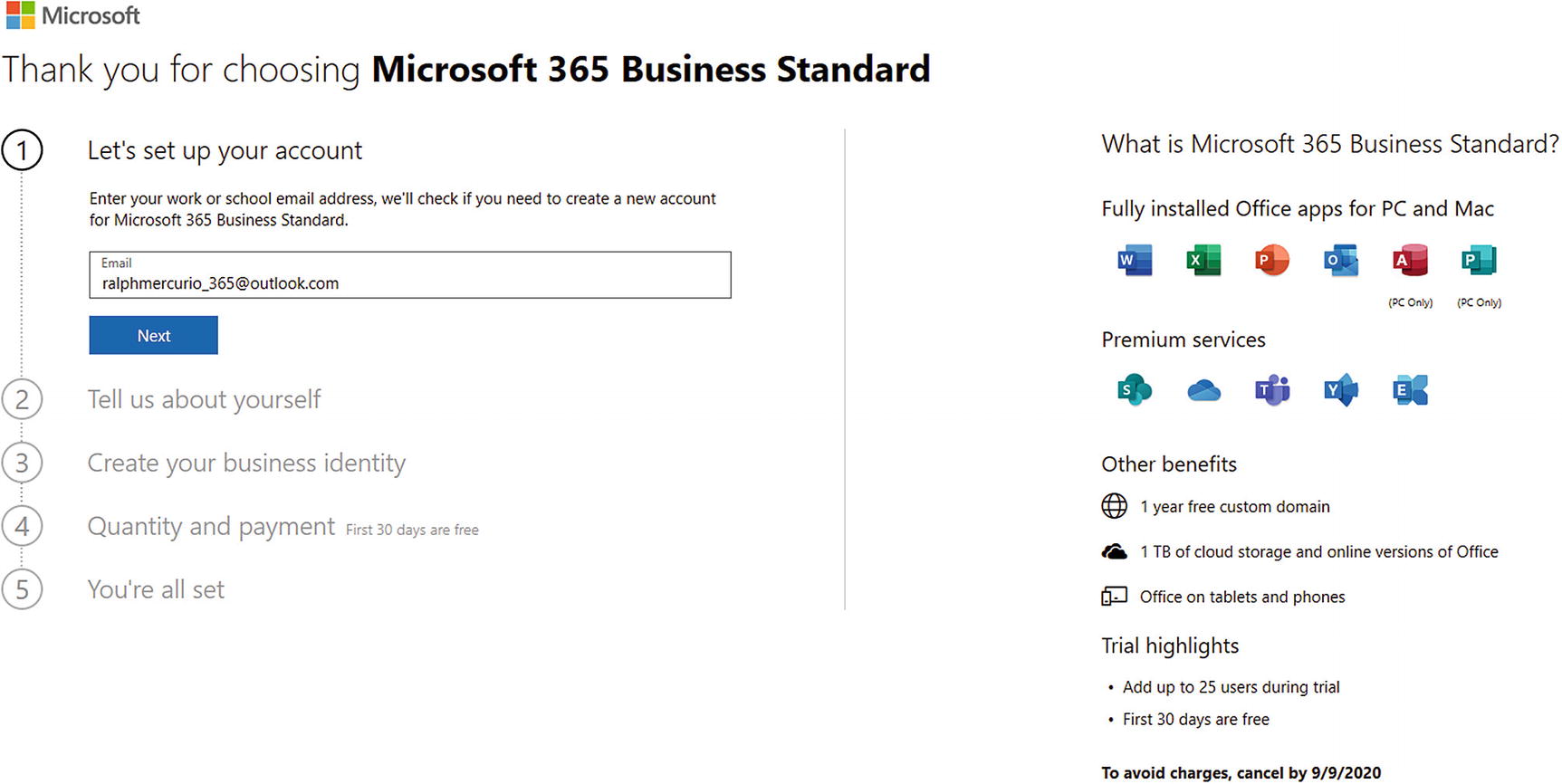
Entering account details to create the Microsoft 365 account
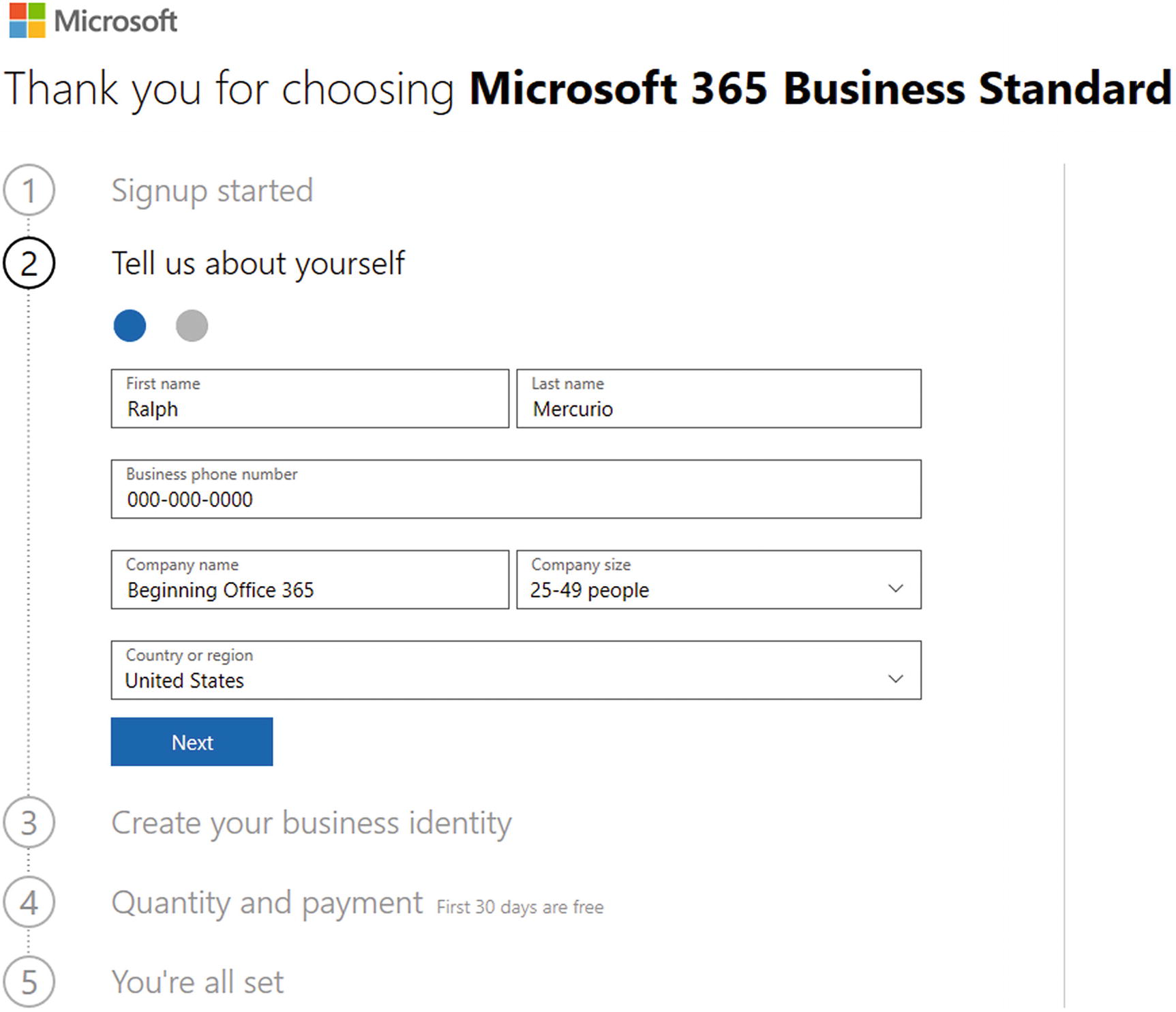
Create your Microsoft 365 account

Proving you are a real person

Providing the Microsoft verification number
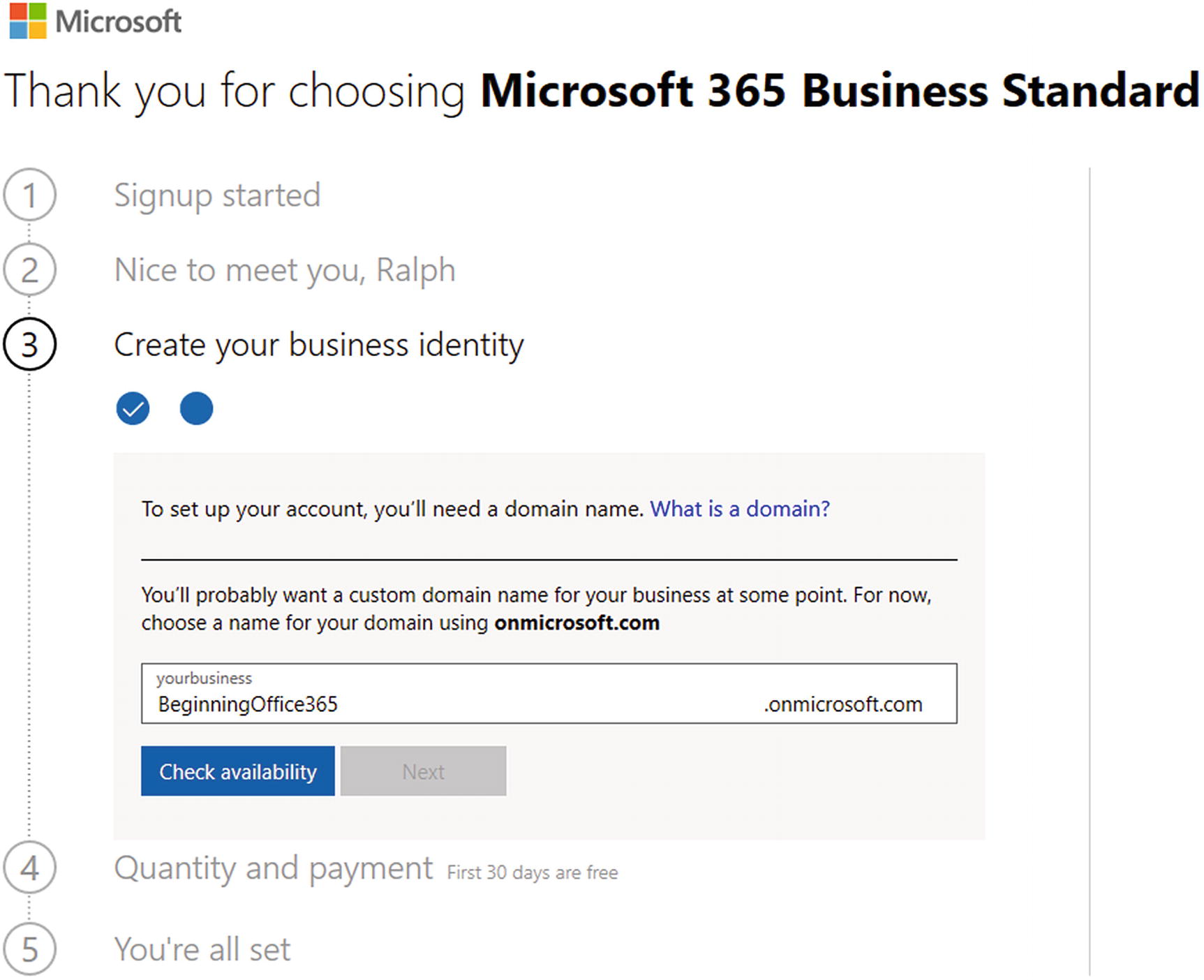
Create your business identity
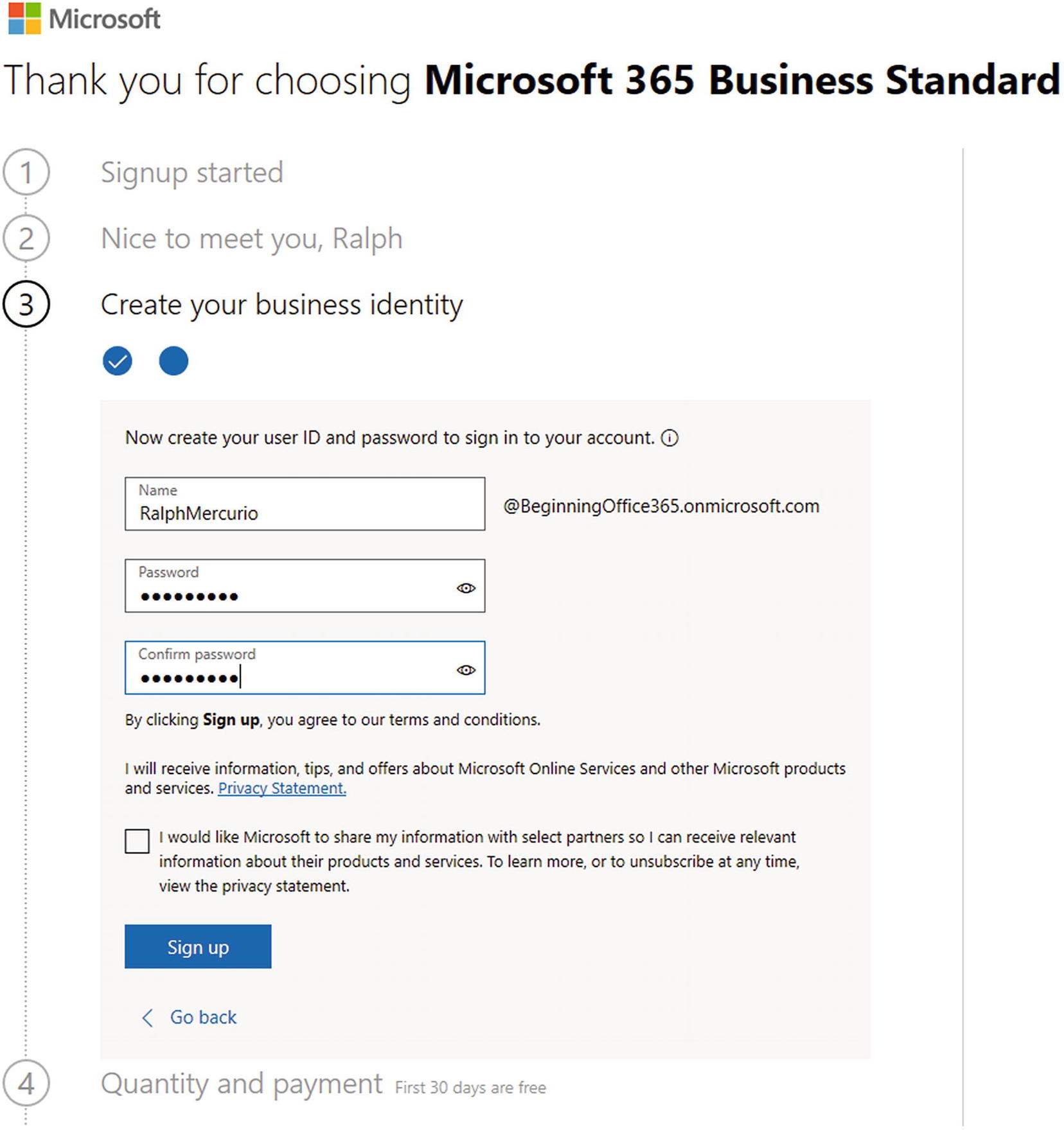
Create the first user
Microsoft no longer offers a free trial without submission of a credit card for future charges. One option is to go ahead and provide payment details and then cancel the trial before billing begins in 30 days. This will give you access to a Microsoft 365 environment for the purposes of this book. If your company already uses Microsoft 365, you can also use that 365 tenant to familiarize yourself with the topics in this book.
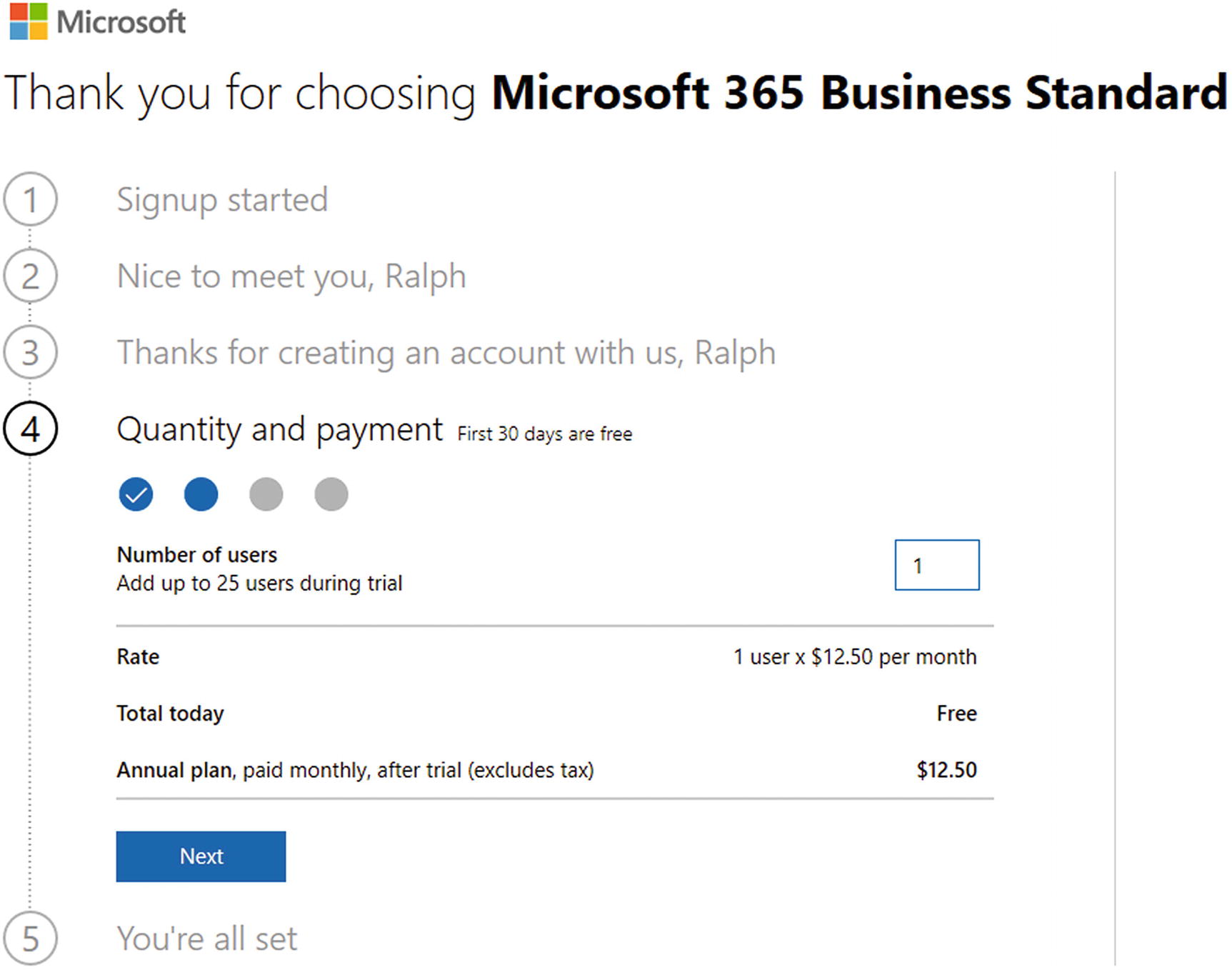
Quantity and Payment
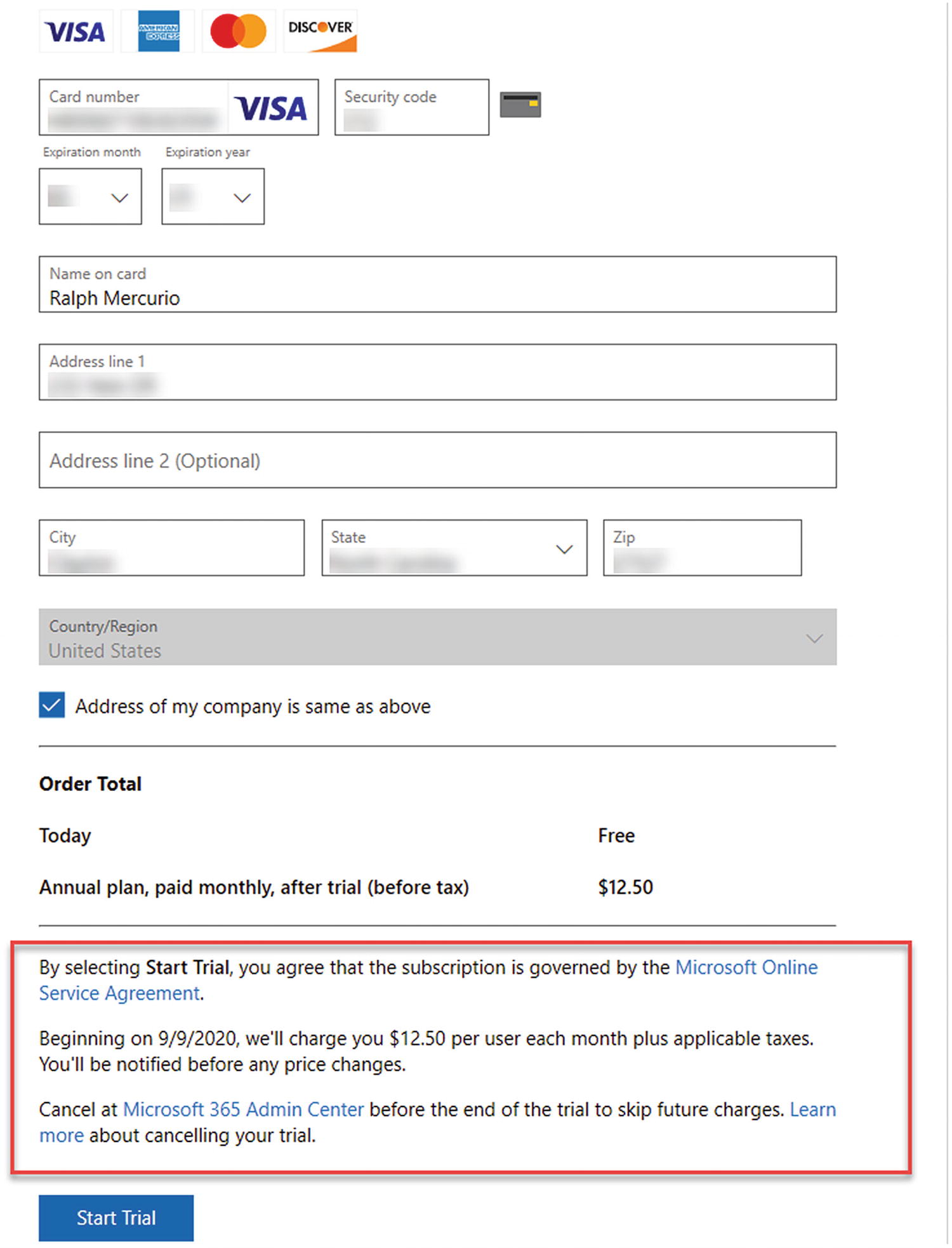
Provide payment details and start the trial

Confirmation screen

Exiting the Microsoft 365 setup
You’ll be redirected to the Microsoft 365 admin center, which is the heart of Microsoft 365. Within the admin center, you will have control over settings and users, as well as the administrative oversight of all Microsoft 365 applications. Please be sure you are comfortable with how to cancel your subscription to avoid being charged. To cancel your subscription, click “Billing” ➤ “Your products.” You will see the option to cancel the trial under “More actions” under Buy now.
Logging into Microsoft 365 for the First Time!
Ready, set, go! Navigate to your favorite supported web browser to www.office.com and select the “Sign in” link located in the center of the page. If you already have access to a tenant and feel comfortable using it, enter the appropriate credentials. If you created a trial tenant as described, enter the email and password that were used during the creation of the subscription.
Once you authenticate, you will be presented with the Microsoft 365 screen. This screen contains some of the applications (see Figure 1-12) you are licensed to use, a rollup (see Figure 1-13) of documents you recently accessed, and a list of SharePoint sites you recently accessed (see Figure 1-13).
Great care has been taken to ensure that the images are correct. However, with any SaaS offering, the product can be changed by the vendor at any time. Even though the product may change, the information will still be relevant.

Microsoft 365 home screen

Recently viewed documents and SharePoint sites
The home screen also contains a few key areas that you can use to find applications and change your settings or Microsoft 365 experience.
App Launcher (the Waffle)

The Microsoft 365 app launcher
The app launcher is always available in the upper-left corner of Microsoft 365 and any application you are using. It provides links to launch the applications we will be discussing, and it provides an admin interface for Microsoft 365 administrators.
Cog

The Microsoft 365 cog
My Account

My Account menu
The My Account settings related to your account are Office ProPlus installs and which computer they have been installed on, personal info, and which licenses you are personally assigned.
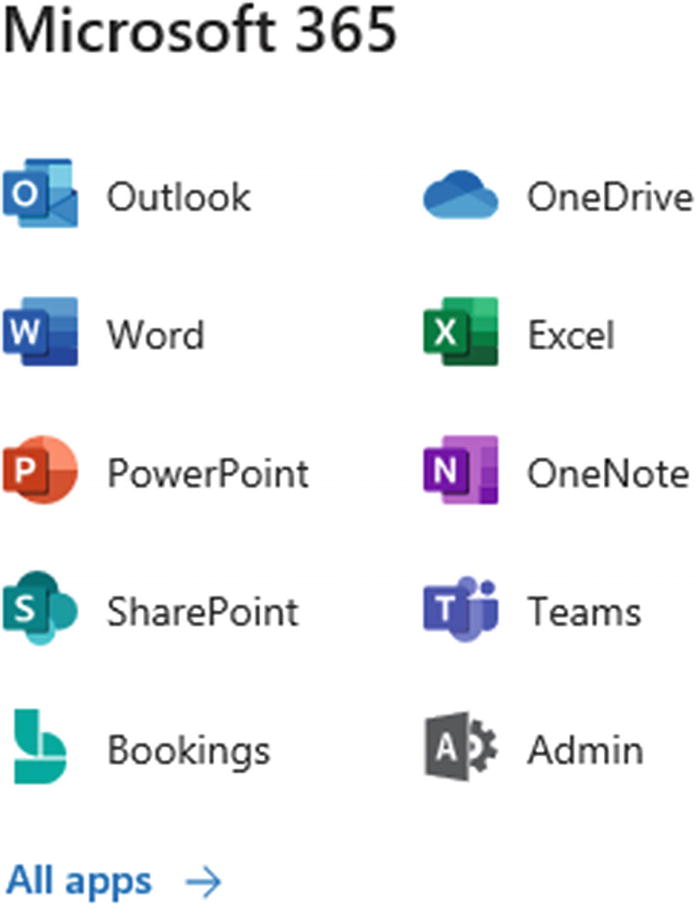
The collaboration apps of Microsoft 365 via the app launcher
Some of the applications aren’t shown in the app launcher and are available by clicking the “All apps” link located below the Bookings application. Clicking this link shows every application, including some that are not discussed in this book.
Microsoft 365 Collaboration Applications
Now that I have discussed Microsoft 365 and you feel comfortable with what it is, how it works, and why you should use it, let me introduce each of the applications I will be discussing in the book.
Outlook
Mail: This application is your inbox for email communication. You can send/receive emails to/from anyone just as you do now.
People: This is your standard Outlook address book but with some extended features, which I will discuss in a later chapter.
Calendar: Just like the Outlook Calendar, you may have been using it for years. Use it to schedule meetings with other people, days you might not be in the office, and so on.
Tasks: This application contains all the tasks from Outlook that you have created or the application has created on your behalf.
This version of Outlook is commonly referred to as web mail.
Office ProPlus
Word: Arguably the world’s most widely used word processing program. Create documents, resumes, and other content using one of the world’s most popular word processing programs.
Excel: Create powerful spreadsheets, charts, and insights. A workhorse of the Office platform for years.
PowerPoint: Create engaging presentations for meetings. Just don’t make them too long.
OneNote: Excellent application for taking notes, I use it almost every day, and it has replaced my little treasure trove of Post-It notes all over my desk.
Sway: Create newsletters and other documents and share them easily.
Outlook: Like Outlook in terms of functionality, but this version is installed on your device.
OneDrive
OneDrive allows you to store files in the cloud and access them from anywhere and on nearly every type of device. Items can be shared with users internally and externally; you can also view and edit documents in Office Online or the client apps of Office 2019.
SharePoint
One of the core pillars of collaboration in Microsoft 365, SharePoint offers document management, sites, and collaboration tools, and it integrates with Office 2019.
Microsoft 365 Teams
An explosive offering from Microsoft, Teams enables teams or smaller groups to work together in one application instead of working in different applications and then using a common application to collaborate. This differs from most applications because it is based on the concept of chat, not email.
Yammer
Similar to Teams, Yammer is designed to foster communication and disseminate information to the entire organization, ideally replacing email as the primary method. Employees can subscribe to groups and interact with other employees across the organization.
Power Automate
Power Automate allows users to create no-code workflows that can be used with the Microsoft 365 platform or as a connector to other external systems. This new application blurs the line and works across many applications.
Planner
Planner offers “light” project management via the ability to keep track of tasks and resources for small projects that don’t require a project manager to manage the project.
Forms
Microsoft’s form offering to tackle the issue of collecting information from end users, Forms gives you the ability to create forms and surveys and then view the results within an easy-to-use dashboard.
Power Apps
Power Apps allows for application development that works across multiple device platforms and easily connects to your data sources. Examples include an organization browser or address book or capturing meeting minutes. Power Apps includes templates and connectors to streamline the development of these applications. It’s a ground-breaking application from Microsoft and can be used to easily deploy an application to solve a business issue.
Stream
Microsoft Stream provides a rich collaborative platform for video sharing in a secure manner. This platform allows video content to be published and searchable; it gives everyone in the organization the ability to create video content.
Power BI
This app strives to offer data analytics and dashboards to present data to make informed decisions, analyze trends, and become the reporting standard in Microsoft 365.
Summary
Microsoft has gone to great lengths in investing in and creating Microsoft 365. From the stability of the infrastructure, the disaster recovery planning perspective, and the affordable pricing structure, Microsoft 365 is a great tool to increase productivity, reduce administrative overhead, and empower users with the tools necessary to make their work successful.
If you are already using Microsoft 365 in your organization, then you are well on your way to understanding the collaboration apps mentioned earlier in this chapter. If not, I hope the walk-through of setting up a trial account was successful and now you are ready to explore the basics of the Microsoft 365 collaboration apps.
In the next chapter, you will explore SharePoint Online, a document-centric application that allows users to create and view SharePoint Online sites, manage documents, and create a collaborative document environment.
